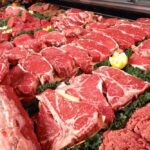Flood Preparedness For Livestock Farmers: A Comprehensive Guide

Table of Contents
Assessing Your Risk: Understanding Flood Vulnerability on Your Farm
Effective flood management begins with understanding your farm's vulnerability. A thorough risk assessment is the cornerstone of successful flood preparedness for livestock farmers.
Identifying Flood-Prone Areas
Pinpointing areas on your farm most susceptible to flooding is paramount. This involves:
- Utilizing GIS mapping: Geographic Information Systems (GIS) can overlay topographical data with historical floodplains to identify high-risk zones.
- Consulting local agricultural extension services: These services often possess detailed local flood history and can offer invaluable advice tailored to your region.
- Observing past flood marks: Look for evidence of previous flooding, such as sediment lines or debris accumulation, to identify potential flood zones. This visual assessment provides crucial on-the-ground information.
Evaluating Livestock Vulnerability
Different livestock species exhibit varying levels of susceptibility to flood-related hazards:
- Cattle: Prone to hypothermia, drowning, and stress-related illnesses. Calves and older animals are particularly vulnerable.
- Sheep: Highly susceptible to hypothermia and drowning due to their smaller size and wool coats which can become waterlogged.
- Pigs: Susceptible to stress, disease, and injury in flood conditions. Their confinement makes them vulnerable to drowning or being swept away.
- Poultry: Extremely vulnerable to drowning and hypothermia. Flooding can also contaminate feed and water sources, leading to disease outbreaks.
Consider the age and health of your animals when evaluating vulnerability. Younger and older animals are generally more susceptible to stress and illness.
Developing a Farm-Specific Flood Risk Assessment
Creating a farm-specific flood risk assessment is a proactive step in flood preparedness for livestock farmers. This involves:
- Data collection: Gather information on your farm's location, topography, soil type, historical flood data, and livestock inventory.
- Analysis: Identify potential flood scenarios (e.g., minor flooding, major flooding) and their likely impact on your farm and livestock.
- Documentation: Create a written document outlining your farm's flood risk, including identified vulnerable areas and potential consequences. This document will be vital for your emergency plan.
Creating a Pre-Flood Emergency Plan: Protecting Your Livestock
A well-defined pre-flood emergency plan is crucial for minimizing losses and ensuring animal safety. This forms the core of effective flood preparedness for livestock farmers.
Developing an Evacuation Plan
A detailed evacuation plan is essential:
- Animal Identification: Ensure all animals are clearly identifiable (e.g., ear tags, branding). This is critical for tracking animals during and after evacuation.
- Transportation Methods: Secure appropriate transport, such as trailers or trucks, well in advance. Ensure they're in good working order and ready for immediate deployment.
- Designated Safe Locations: Identify high-ground areas on your property or nearby locations suitable for temporary relocation. Pre-arrange access if necessary.
- Communication Protocols: Establish clear communication pathways with neighbours, local authorities, and veterinary services.
Preparing Essential Supplies
Stockpiling essential supplies is a critical component of flood preparedness for livestock farmers:
- Emergency Feed Storage: Store sufficient feed for several days, well protected from potential flooding.
- Water Containers: Have ample clean water containers ready for both animals and humans.
- First Aid Kit for Animals: Assemble a kit containing essential medications and supplies for treating common flood-related injuries.
- Temporary Shelters: Secure temporary shelters such as sturdy tents or barns for temporary relocation.
Establishing Communication Protocols
Maintaining communication is vital during a flood emergency:
- Designated Contact Persons: Identify key contact persons for emergencies, including neighbors, local authorities, and veterinary services.
- Weather Radio: Invest in a battery-powered weather radio to receive timely flood warnings.
- Emergency Alert Systems: Sign up for local emergency alert systems to receive notifications.
- Community Networks: Join local farmer networks to share information and support during emergencies.
Post-Flood Recovery: Caring for Your Livestock After a Flood
Effective post-flood recovery is equally critical to minimizing long-term losses. This stage is crucial in the overall flood preparedness for livestock farmers strategy.
Assessing Damage and Animal Welfare
Following a flood, immediately assess the damage and your animals’ well-being:
- Checking for Injuries: Carefully examine each animal for injuries, such as cuts, bruises, or broken bones.
- Signs of Hypothermia or Stress: Watch for signs of hypothermia (shivering, lethargy) or stress (restlessness, loss of appetite).
- Access to Clean Water and Feed: Ensure animals have access to clean water and uncontaminated feed.
Cleaning and Sanitizing Facilities
Prevent disease outbreaks by thoroughly cleaning and sanitizing your facilities:
- Removing Debris: Remove all flood-damaged materials, including mud, debris, and contaminated bedding.
- Disinfecting Facilities: Thoroughly disinfect all affected areas using appropriate disinfectants.
- Disposal of Contaminated Materials: Dispose of contaminated materials according to local regulations to prevent environmental contamination.
Seeking Assistance and Resources
Don't hesitate to seek assistance after a flood:
- Relevant Government Agencies: Contact relevant government agencies for assistance programs and support.
- Insurance Providers: File insurance claims promptly to cover losses.
- Veterinary Emergency Services: Contact veterinary services for assistance with injured or sick animals.
- Farmer Support Networks: Reach out to local farmer support networks for advice and assistance.
Conclusion: Protecting Your Livestock Through Effective Flood Preparedness
Proactive flood preparedness for livestock farmers is not just good practice; it's essential for the long-term health and viability of your farm. This guide has highlighted the importance of comprehensive risk assessment, detailed emergency planning, and efficient post-flood recovery strategies. By implementing these strategies, you can significantly minimize the impact of future flood events on your livestock and your farm's profitability. Start building your comprehensive flood preparedness plan for your livestock today! Download our free checklist to help you get started.

Featured Posts
-
 The Los Angeles Wildfires A Case Study In The Growing Market Of Disaster Betting
May 07, 2025
The Los Angeles Wildfires A Case Study In The Growing Market Of Disaster Betting
May 07, 2025 -
 Najpopularniejsze Teksty Jacka Harlukowicza Z Onetu W 2024 Analiza Zasiegu
May 07, 2025
Najpopularniejsze Teksty Jacka Harlukowicza Z Onetu W 2024 Analiza Zasiegu
May 07, 2025 -
 De Echte Soldaat Van Oranje Het Leven Van Spion Peter Tazelaar
May 07, 2025
De Echte Soldaat Van Oranje Het Leven Van Spion Peter Tazelaar
May 07, 2025 -
 The Baba Yaga Role A Unique John Wick Experience In Las Vegas
May 07, 2025
The Baba Yaga Role A Unique John Wick Experience In Las Vegas
May 07, 2025 -
 Lewis Capaldis Star Album Continues Chart Success
May 07, 2025
Lewis Capaldis Star Album Continues Chart Success
May 07, 2025
